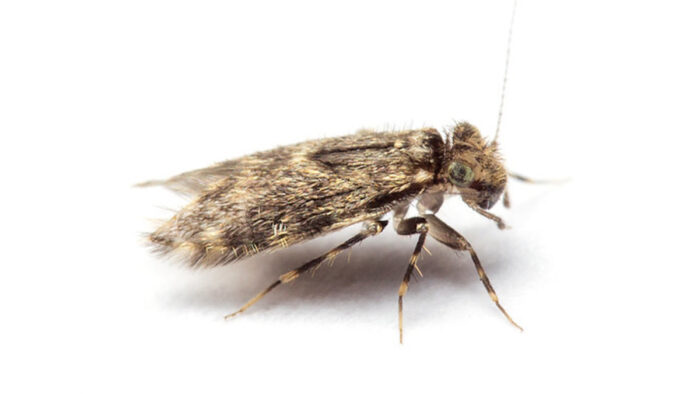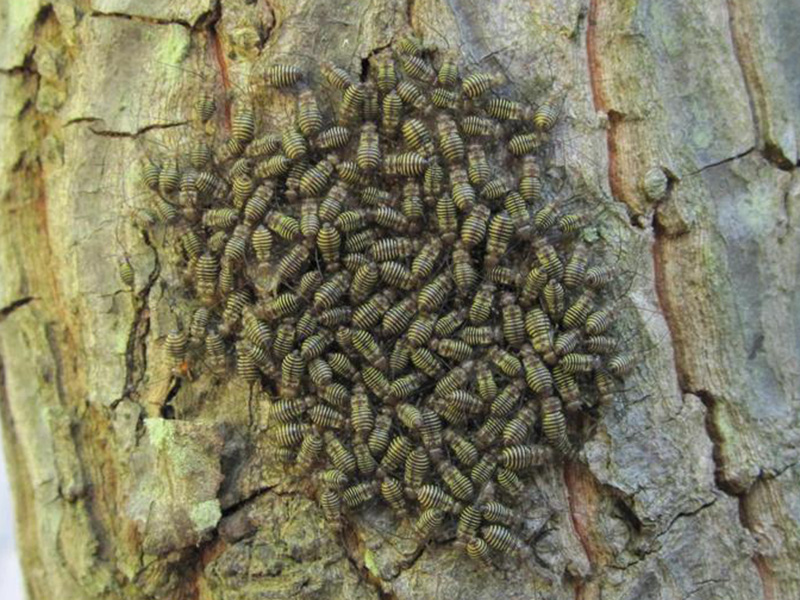
You’ve heard of getting head lice, but did you know your trees can get barklice? For me, anything with the word lice in the name sure sounds like bad news. Every once in a while, I get an email from a homeowner with a photo of tiny insects covering the bark of a tree in their yard. Often this turns out to be a herd of barklice. Frequently the photo from the homeowner will be accompanied with the question “What should I spray to kill them?” Fortunately, the answer is easy: Barklice are harmless to the shrubs and trees they live on. They are a very interesting group of insects, and although it might be a bit alarming to encounter them in the garden, they really are doing no harm. As long as you can tell the difference between them and aphids, they may even be helpful to your plants.
Did you catch that I called a group of barklice a herd? In fact, some people call them “tree cattle.” This is a pretty accurate description. Barklice travel in groups around the bark of a tree. They are particularly attracted to trees with smoother bark. If you disturb them, they will scatter and then return to their herd.

Know the difference between barklice and aphids
During some life stages, barklice can be confused for plant-damaging aphids, especially due to their wings being similar. However, aphids bear tubular sucking mouthparts, have fewer segments in their antennae (about six versus many in barklice), and often have distinct tail pipes. With the use of a hand lens and some investigation, you should be able to tell the difference.
Don’t worry if you see webs
Barklice are also silk spinners. Eggs often rest beneath these silken mats. In rare cases, dense populations of barklice can create silken veils that encase entire tree trunks and branches. For the gardener, this is again nothing to worry about. Barklice will often devour their web at the end of the season. They really are one of nature’s best cleanup crews.
I reached out to Matthew Bertone, director of the Plant Disease and Insect Clinic at North Carolina State University, to ask more about barklice. “I think barklice are one of the most underappreciated groups of insects,” he said. “Often little [is] known by the public despite [them] being very common out in the environment. I also think barklice are pretty cute, and many have really interesting biologies, including social behaviors. Many species can also be quite attractive or interesting looking. Even their eggs can be amazingly intricate and beautiful.”

Are barklice beneficial insects?
Some entomologists suggest that barklice are a benefit to the trees they inhabit. By cleaning up fungi, algae, dead plant tissue, and other debris, they can help your trees. Again, they are natural recyclers. Often we are suspicious of any insect we don’t know a lot about. Taking the time as gardeners to distinguish between pests, beneficial insects, and even neutral bugs helps us move toward a more harmonious balance in our gardens. Many new gardeners will go to war on almost any insect they see in their yards. As we mature in our knowledge, we understand that some insects are working for us to keep equilibrium in the garden.
If you have never seen this interesting insect, perhaps this will be your year. Often in the southeastern United States, you might start to see them in April as nymphs. Nymphs are dark gray with lighter-colored bands between their abdominal segments. If you see them, let them do their thing; they are just passers-by on your plants.
—Andy Pulte is a faculty member in the plant sciences department at the University of Tennessee.


















Comments
Log in or create an account to post a comment.
Sign up Log in